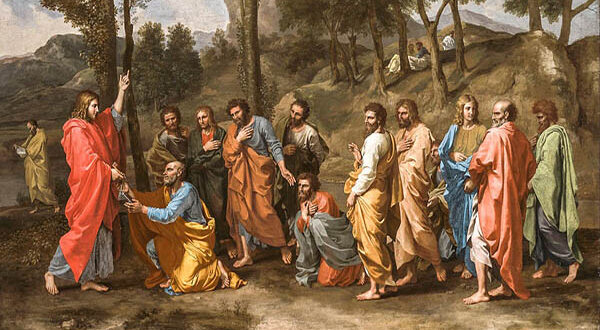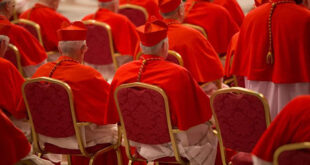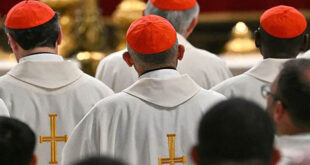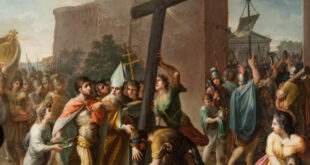A spiritual guide to understanding the living source of the Catholic faith
Introduction: A Fundamental Question
In the life of every believer, there comes a moment when essential questions arise: What is our faith really based on? Is everything we believe found in the Bible? What place does Apostolic Tradition have? Is it a human addition or a fundamental part of the deposit of faith? These questions are not new, but today, in a world dominated by the slogan “Bible only” (sola Scriptura), they become especially urgent.
This article aims to be a bridge between the heart of the modern believer and the millennia-old roots of the Catholic faith. We will not only explain what Apostolic Tradition is, but also how it forms part of Divine Revelation, what its relationship with Sacred Scripture is, and how it can transform our daily spiritual life. Because Tradition is not a burden of the past, but a living current that connects us directly with Christ.
I. What Is Apostolic Tradition?
Apostolic Tradition is the set of teachings, practices, prayers, celebrations, and structures handed down by the apostles under the inspiration of the Holy Spirit and faithfully preserved by the Church. It is not just another human tradition or cultural custom: it is a constitutive part of Divine Revelation, alongside Sacred Scripture.
“So then, brethren, stand firm and hold to the traditions which you were taught by us, either by word of mouth or by letter.”
—2 Thessalonians 2:15
This verse is key: Saint Paul does not oppose oral tradition to written tradition, but presents them as complementary. The apostle did not think everything had to be written immediately; on the contrary, many teachings were passed down by word of mouth and lived in community before being written down.
II. Bible and Tradition: Rivals or Companions?
Sacred Scripture and Tradition are not two separate sources, as if each had its own “portion” of truth. Rather, they form a single source of Divine Revelation, as taught by the Second Vatican Council in the constitution Dei Verbum:
“Sacred Tradition and Sacred Scripture form one sacred deposit of the Word of God, committed to the Church.”
(Dei Verbum, 10)
The Bible was born within the living Tradition of the Church. The New Testament itself was written decades after Christ’s Resurrection, in communities that were already celebrating the Eucharist, had an episcopal hierarchy, were baptizing, and preaching the Gospel.
So, where does the Bible end and Tradition begin? The question, while valid, is based on a false dichotomy. There is no fixed “border”: they intertwine, enlighten, and interpret each other. The modern error has been to separate them, as if Tradition were dispensable or suspicious.
III. Tradition in the History of the Church
Since the first century, the Church has lived within Tradition. Consider a few examples:
- The hierarchical structure of the Church (bishops, presbyters, and deacons) existed before the Gospel of John was written.
- The biblical canon, that is, which books belong to the Bible, was discerned by the Church through Tradition and was not closed until the end of the fourth century.
- Trinitarian doctrine, Marian dogma, devotion to the saints, the liturgical formulas of baptism and the Mass: all of this developed under the influence of Tradition guided by the Holy Spirit.
When someone says, “I only believe what is in the Bible,” they ignore that even the Bible was compiled, preserved, and transmitted by a Church already acting according to Apostolic Tradition.
IV. Tradition and the Magisterium: Three Inseparable Pillars
The Church teaches that Divine Revelation rests on three pillars:
- Sacred Scripture – the written Word of God.
- Apostolic Tradition – the Word of God passed on orally and lived.
- The Magisterium – the living teaching authority of the Church that faithfully interprets the Word.
“This teaching office is not above the Word of God, but serves it, teaching only what has been handed on.”
(Dei Verbum, 10)
Therefore, Tradition cannot be read or understood apart from the Magisterium of the Church, which guarantees fidelity to Christ. Not every ancient custom is Apostolic Tradition. Only those teachings that originate from apostolic testimony and have been recognized by the universal Church, under the guidance of the Pope and the bishops in communion with him.
V. Tradition Today: A Living Guide for Uncertain Times
In a world that changes at lightning speed, many seek certainties. And some, even within the Church, may fall into the error of thinking that the Bible alone is sufficient to respond to modern challenges. However, Tradition is a sure compass. Because it is not a burden, but the living memory of God’s people.
Thanks to Tradition, for example:
- We know how to celebrate the Eucharist with reverence.
- We preserve the Church’s moral doctrine on issues like life, sexuality, and marriage.
- We have access to the spiritual wealth of the Church Fathers, the saints, and the ecumenical councils.
- We can discern heresies and doctrinal trends that arise in each age.
Tradition makes us truly Catholic: not followers of a single book, but members of a history, a mystical body, a living communion that spans the centuries.
VI. Practical Applications for Today’s Believer
How can we live Apostolic Tradition today without falling into sterile traditionalism or superficial novelty?
- Delve into the Church Fathers: Read Saint Irenaeus, Saint Augustine, Saint John Chrysostom. They are like beacons illuminating the early faith.
- Love the traditional liturgy: Participate in Holy Mass with reverence, learn about the ancient rites, appreciate Latin, Gregorian chant, and sacred symbolism.
- Form your conscience according to perennial doctrine: Don’t be swayed by what is trendy. Study the Catechism, the councils, and the encyclicals.
- Live the faith in communion with the Church: Tradition is not individualistic. It is transmitted in community—within family, parish, and in fidelity to the Pope.
- Pray with ancient words: The Rosary, litanies, the Liturgy of the Hours… these are treasures connecting you with centuries of uninterrupted prayer.
VII. A Witness of Fidelity: Mary, Bearer of Tradition
The Virgin Mary did not write a single line of the Bible. Yet she is the living custodian of the Word of God. Her fiat, her contemplative silence, her constant presence in the life of Christ and the Church make her the perfect model of one who receives, transmits, and lives Tradition.
“But Mary kept all these things, pondering them in her heart.”
—Luke 2:19
So too are we called to receive what has been handed down, not as dead letters, but as living Word that transforms us.
Conclusion: A River That Never Stops Flowing
Apostolic Tradition is not a stagnant lake, but a river that flows from Christ’s pierced side and reaches us through the Church. It does not compete with Scripture; rather, it accompanies, interprets, and keeps it alive.
In times of confusion, doubt, and relativism, Tradition is a guarantee of authenticity, a sacred inheritance, and a call to live the faith with depth, beauty, and fidelity.
Returning to Tradition is not going backward. It is returning to the sources, to drink the living water that flows from the very heart of God.
“Do not be carried away by all kinds of strange teachings. Jesus Christ is the same yesterday and today and forever.”
—Hebrews 13:8






